In today's fast-paced world, people are constantly seeking innovative solutions to simplify their lives and enhance their surroundings. One such solution that has gained immense popularity in recent years is artificial grass. Also known as synthetic turf or synthetic grass, artificial grass offers a low-maintenance, visually appealing alternative to natural grass. This article will delve into the benefits and applications of artificial grass, highlighting why it has become a preferred choice for homeowners and businesses alike.
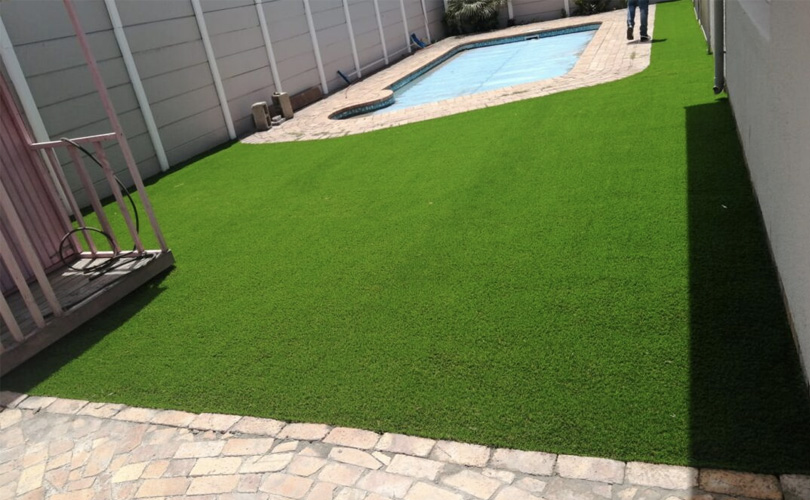
Understanding Artificial Grass: What Is It?
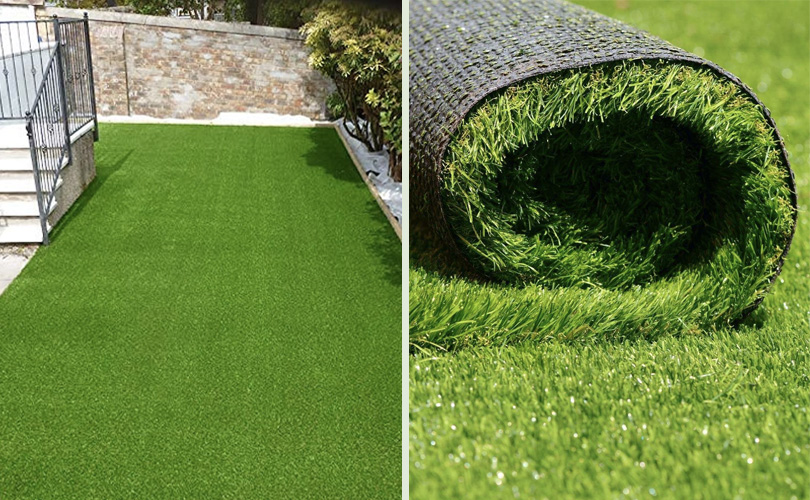
Artificial grass is a synthetic alternative to natural grass that replicates the look and feel of a lush green lawn. It is made using advanced materials, such as polyethylene or polypropylene, which are intricately woven to create a realistic texture and appearance. The blades of artificial grass are designed to mimic the color and structure of natural grass, offering a visually appealing and natural-looking landscape.
The Benefits of Artificial Grass
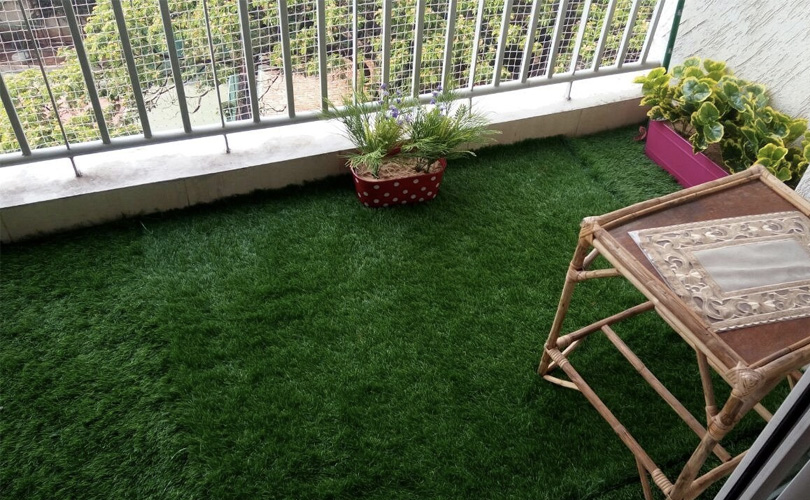
Artificial grass offers numerous benefits that make it a highly attractive option for both residential and commercial applications. Let's explore the advantages in detail:
1. Low Maintenance
Artificial grass has several benefits, one of which is that it requires little upkeep. Artificial grass avoids these time-consuming and labor-intensive duties that are required for regular maintenance on natural grass, such as mowing, watering, and fertilizing. Once installed, artificial grass requires minimal upkeep, saving both time and money. Instead of spending weekends on yard work, homeowners can relax and enjoy their lush green lawns without the hassle of constant maintenance.
2. Year-Round Greenery
With artificial grass, you can enjoy a beautifully green lawn throughout the year, regardless of the season or weather conditions. Natural grass often turns brown and becomes dormant during droughts or extreme temperatures. Artificial grass, on the other hand, maintains its vibrant color and lush appearance regardless of the weather. Whether it's the scorching heat of summer or the freezing cold of winter, your artificial lawn will remain visually appealing and inviting.
3. Enhanced Durability
Artificial grass is extremely long-lasting and can sustain considerable foot traffic and regular use without deterioration. Unlike natural grass, which can develop bald patches or become uneven due to heavy activity, artificial grass retains its integrity and aesthetic appeal. It is an excellent choice for households with children or pets who love to play outdoors. You can enjoy a beautiful lawn without worrying about constant maintenance or damage caused by regular use.
4. Water Conservation
Water scarcity is a major concern in many areas. Artificial grass helps address this issue by significantly reducing water consumption. Unlike natural grass, which requires regular watering to stay healthy and green, artificial grass doesn't need any irrigation. This not only conserves water but also reduces water bills and alleviates the strain on local water resources. By opting for artificial grass, you can contribute to water conservation efforts while still enjoying a beautiful, green lawn.
5. Allergy-Friendly
Natural grass can trigger allergies in some individuals due to pollen or other allergens. Artificial grass is a hypoallergenic option that allows everyone to enjoy the outdoors without discomfort. People with grass allergies can now relax and spend time on the lawn without worrying about sneezing, itching, or other allergic reactions. This makes artificial grass an excellent choice for households with family members who have grass-related allergies or sensitivities.
6. Environmental Benefits
Artificial grass offers several environmental benefits that contribute to sustainability. First, it eliminates the need for harmful pesticides and fertilizers, reducing chemical usage and its impact on the environment. Additionally, artificial grass doesn't require gasoline-powered mowers, further reducing air and noise pollution. Moreover, the absence of irrigation reduces water consumption, conserving this valuable resource. By choosing artificial grass, you can create an eco-friendly outdoor space that promotes sustainability.
7. Cost Savings
While the initial cost of putting artificial grass may be more than that of natural grass, the long-term cost reductions are significant. With artificial grass, you eliminate the need for ongoing expenses such as lawn maintenance services, watering, fertilizers, and equipment. Over time, these savings can add up, making artificial grass a cost-effective solution. Additionally, artificial grass maintains its appearance and durability for years, reducing the need for replacements and additional expenses.
Artificial Grass Applications
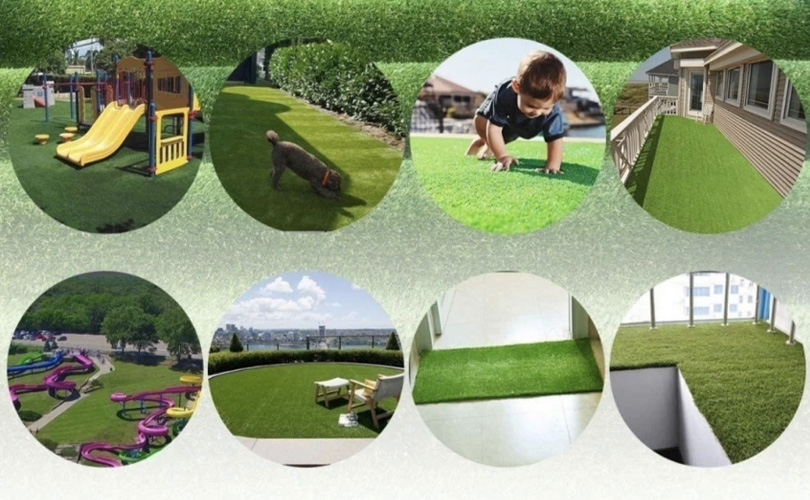
The versatility of artificial grass enables its application in various settings. Let us look at some of the important areas where artificial grass shines:
Residential Use
Artificial grass can transform residential landscapes into beautiful and functional outdoor spaces. It can be used in gardens, lawns, rooftop terraces, balconies, and even indoor areas, bringing the charm of nature into urban living environments. Artificial grass offers homeowners the opportunity to create a low-maintenance, visually appealing landscape that remains green and lush all year round.
Commercial Use
From office complexes to shopping centers, artificial grass has become a popular choice for commercial landscaping. It adds a touch of greenery to urban spaces, creating an inviting and refreshing environment for employees, customers, and visitors. Additionally, it eliminates the need for constant maintenance, allowing businesses to allocate resources to other areas.
Sports and Recreational Use
Artificial grass has revolutionized sports fields and recreational areas. Its durability, even surface, and ability to withstand heavy use make it ideal for football fields, golf courses, tennis courts, and playgrounds. With artificial grass, athletes can enjoy consistent playing conditions and reduced risk of injuries.
Pet-Friendly Solutions
Artificial grass is an excellent option for pet owners who want to create a safe and clean environment for their furry companions. It is resistant to pet waste and easy to clean, providing a hassle-free solution for pet owners. Artificial grass also eliminates the issues of muddy paws and digging, allowing pets to enjoy the outdoors without creating a mess.
Choosing the Right Artificial Grass
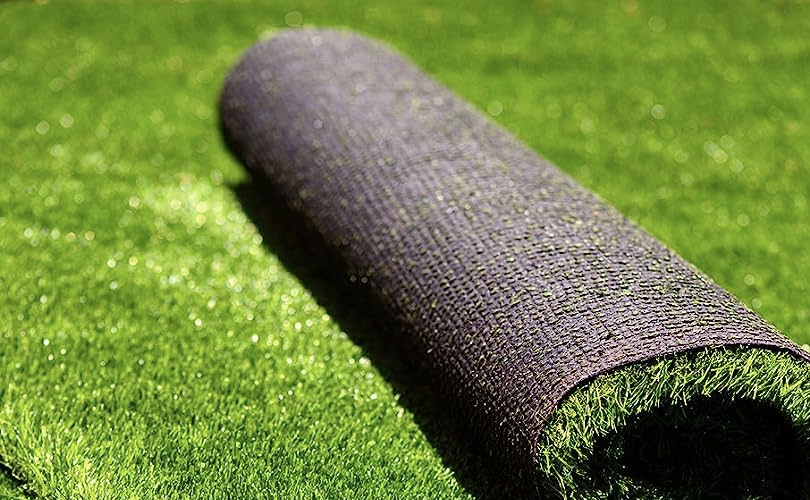
When selecting artificial grass for your specific needs, several factors should be considered:
Quality and Durability
Opt for high-quality artificial grass that is designed to withstand the demands of your intended application. Look for products that come with a warranty, ensuring long-term durability and performance.
Pile Height and Density
Consider the desired pile height and density based on the usage and appearance you are aiming for. Higher pile heights provide a more lush and realistic look, while denser grass offers enhanced durability and resilience.
Backing Material
The backing material plays a crucial role in the stability and drainage capabilities of artificial grass. Ensure that the backing is strong, and durable, and allows proper water drainage to prevent water accumulation.
Color and Blade Variation
Artificial grass comes in various shades of green and blade shapes. Select a color and blade variation that closely resembles natural grass and complements your overall landscape design.
Installation Process: From Preparation to Completion
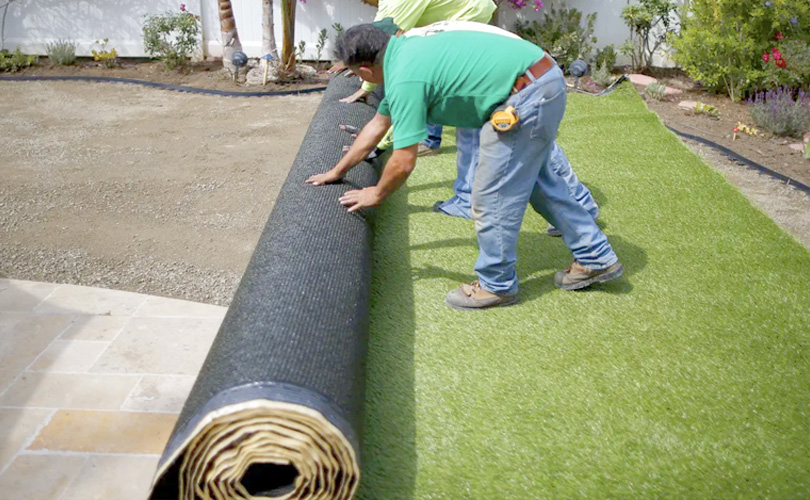
The installation of artificial grass requires careful planning and execution. The following are the major steps in the installation process:
Site Preparation: Clear the area of any existing vegetation, rocks, or debris. Make sure the surface is smooth and clear of impediments.
Base Preparation: Create a stable and well-draining base by adding a layer of crushed stone or gravel. Compact the base to ensure proper stability.
Weed Barrier: Install a weed barrier to prevent weed growth from underneath the artificial grass. This helps maintain a pristine appearance and minimizes maintenance efforts.
Artificial Grass Installation: Lay the artificial grass over the prepared surface, ensuring it fits snugly and aligns correctly. Trim any excess grass and secure the edges using adhesive or landscape staples.
Infill Application: Apply an infill material, such as silica sand or rubber granules, to provide stability, cushioning, and support to the artificial grass. Brush the infill evenly to ensure proper distribution.
Final Grooming: Use a stiff brush or power broom to brush the artificial grass fibers upright. This enhances the aesthetic appeal and ensures an even and natural look.
Maintenance and Care Tips for Artificial Grass
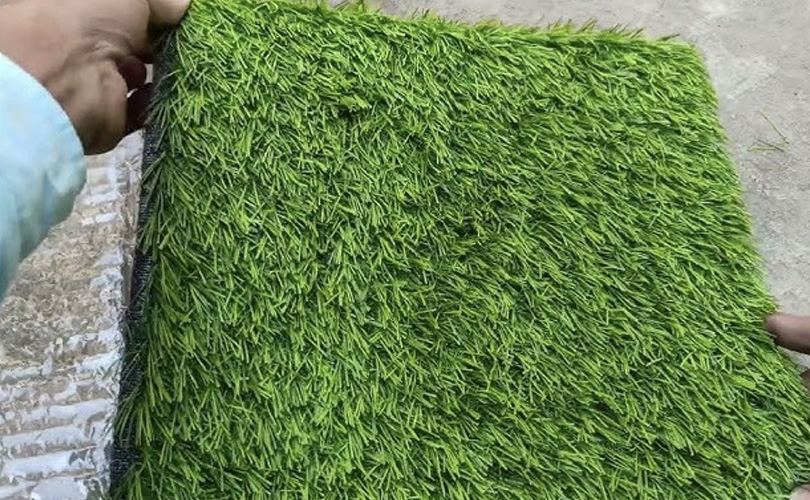
Artificial grass requires minimal maintenance compared to natural grass, but it still requires some care to ensure its longevity, optimal appearance, and performance. Here are detailed maintenance and care tips for artificial grass:
Regular Brushing: Regular brushing is essential to keep the blades of artificial grass upright and prevent matting or flattening. Use a stiff brush or a power broom to brush against the natural grain of the grass. This process helps maintain the aesthetic appeal and resilience of the artificial grass. Brushing also ensures even distribution of the infill material, which provides stability and cushioning.
Remove Debris: Periodically remove debris that may accumulate on the surface of the artificial grass. Leaves, twigs, dirt, and other loose particles can accumulate over time and affect the appearance of the grass. Use a leaf blower, a broom, or simply pick up the larger debris by hand. Regular debris removal helps keep the artificial grass clean and neat.
Clean Spills and Stains: Accidental spills or stains may occur on the artificial grass, especially in areas where pets or children play. Promptly clean up any spills using a mild soap or a suitable artificial grass cleaner. Follow the manufacturer's instructions for cleaning solutions. Rinse the affected area thoroughly with water to ensure complete removal of the cleaning solution and prevent residue buildup.
Pet Waste Management: If you have pets, proper waste management is crucial for maintaining the cleanliness and hygiene of your artificial grass. Promptly remove solid waste and dispose of it properly in a waste bin. Rinse the affected area with water to dilute and wash away any remaining residue. For liquid waste, the drainage capabilities of artificial grass will ensure proper disposal. However, regular cleaning and occasional deodorizing may be necessary to keep the area fresh.
Weed Control: While artificial grass significantly reduces the chances of weed growth, occasional weed control measures may still be required. Inspect the perimeter of the artificial grass and any seams regularly for signs of weed growth. Remove any weeds manually or use a suitable weed killer or herbicide following the manufacturer's instructions. Preventing weed infestation helps maintain the pristine appearance of the artificial grass.
Protect Against Sharp Objects: Avoid placing sharp objects or heavy furniture directly on the artificial grass as they can damage the blades or puncture the backing. Sharp objects like garden tools or high-heeled shoes should be kept off the grass. When placing heavy furniture or objects, use protective mats or furniture pads to distribute the weight evenly and prevent damage to the grass fibers or backing.
Prevent Excessive Heat: Artificial grass can become hot under direct sunlight, particularly in warmer climates. To prevent excessive heat buildup, consider providing shade through the use of umbrellas, awnings, or strategically planted trees. Lightly spraying the surface of the artificial grass with water on hot days can help cool it down and make it more comfortable for use.
Professional Maintenance: While routine maintenance can be done by homeowners, periodic professional maintenance is recommended to ensure the longevity and optimal performance of the artificial grass. Professional maintenance may include deep cleaning, re-infilling, inspecting seams and edges, and checking the overall condition of the artificial grass. Professional maintenance can help address any issues and keep your artificial grass in excellent shape.
Environmental Considerations for Artificial Grass
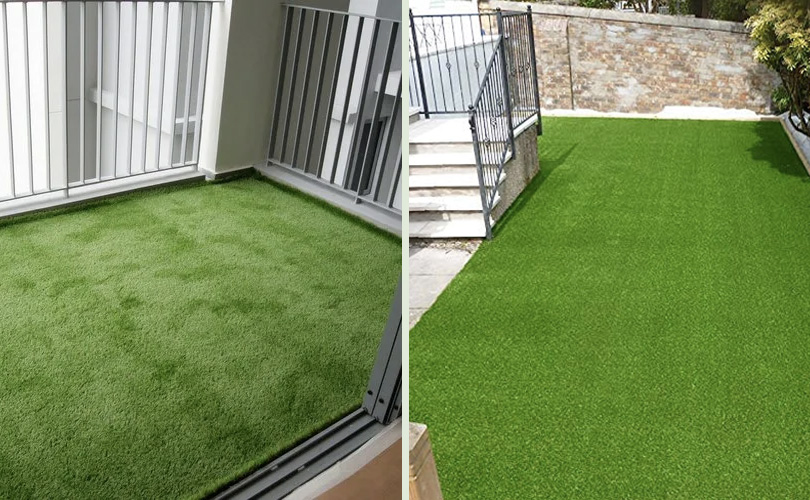
When considering artificial grass as an alternative to natural grass, it's important to understand the environmental implications. While artificial grass offers various benefits, it's essential to be aware of its environmental considerations. Let's explore this topic in detail:
Water Conservation: One of the significant environmental benefits of artificial grass is water conservation. Unlike natural grass, which requires regular watering to maintain its health and appearance, artificial grass doesn't need any irrigation. This reduction in water usage helps conserve water resources, especially in regions prone to drought or areas with limited access to water. By choosing artificial grass, you contribute to water conservation efforts and reduce the strain on water supplies.
Reduced Chemical Usage: Natural grass often requires the use of pesticides, herbicides, and fertilizers to keep it healthy and free from pests or diseases. These chemicals can have detrimental effects on the environment, polluting water sources and harming wildlife. Artificial grass eliminates the need for these chemicals, reducing their usage and minimizing their impact on ecosystems. By opting for artificial grass, you contribute to a cleaner and healthier environment.
Air and Noise Pollution Reduction: Maintaining natural grass involves the use of gasoline-powered lawnmowers, trimmers, and other equipment that emit pollutants into the air. These emissions contribute to air pollution, negatively impacting air quality and human health. Additionally, the noise generated by these machines can cause noise pollution, disturbing both humans and wildlife. Artificial grass eliminates the need for such equipment, resulting in reduced air and noise pollution.
No Need for Watering Equipment: Natural grass often requires the use of sprinkler systems or irrigation equipment to ensure sufficient watering. These systems consume energy and contribute to greenhouse gas emissions. By opting for artificial grass, you eliminate the need for watering equipment, reducing energy consumption and the associated carbon footprint. This helps mitigate climate change and promotes sustainable practices.
Reduced Maintenance Requirements: Maintaining natural grass involves regular mowing, trimming, and edging, which require the use of energy-intensive equipment and fossil fuels. Artificial grass significantly reduces maintenance requirements, minimizing the use of these equipment and resources. This reduction in energy consumption further contributes to environmental conservation efforts.
Longevity and Durability: Natural grass may require periodic reseeding or replacement due to wear and tear or damage caused by extreme weather conditions. Artificial grass, on the other hand, is designed to be durable and long-lasting. Its resilience ensures that it can withstand heavy foot traffic, extreme weather, and regular use without deteriorating or losing its visual appeal. The longevity of artificial grass reduces the need for replacements, minimizing waste and the environmental impact associated with new installations.
Recycling and Disposal: When it's time to replace artificial grass, many manufacturers now offer recycling programs to properly dispose of the old materials. The recycled materials can be repurposed or used in the production of new synthetic turf. Recycling artificial grass reduces waste sent to landfills and promotes a circular economy approach.
Cost Analysis: Artificial Grass vs. Natural Grass
When considering the installation of a new lawn or the replacement of an existing one, it's essential to evaluate the cost implications of both artificial grass and natural grass. While the initial cost of artificial grass may be higher, there are several factors to consider when conducting a cost analysis. Let's explore the cost comparison between artificial grass and natural grass in detail:
Initial Installation Costs
Artificial Grass: The installation cost of artificial grass includes various components such as the purchase of the turf, ground preparation, labor, and additional materials like infill and adhesive. The specific cost will vary depending on factors such as the size of the area, the quality of the artificial grass, and the complexity of the installation process. However, artificial grass generally requires a higher upfront investment compared to natural grass due to the materials involved and the need for professional installation.
Natural Grass: The initial installation cost of natural grass typically includes the purchase of seeds or sod, soil preparation, irrigation systems, fertilizers, and labor. While the cost of seeds is relatively lower, the expenses associated with soil preparation, irrigation systems, and ongoing maintenance can add up. Natural grass requires significant investment in terms of time, effort, and materials to establish a healthy and visually appealing lawn.
Maintenance and Ongoing Costs
Artificial Grass: One of the significant advantages of artificial grass is its lower long-term maintenance costs compared to natural grass. Artificial grass does not require mowing, watering, fertilizing, or pesticide treatments. This eliminates ongoing expenses related to equipment, water bills, and lawn care products. While occasional brushing, debris removal, and cleaning may be necessary, these maintenance tasks are minimal in comparison to the regular upkeep required for natural grass.
Natural Grass: Maintaining a natural grass lawn involves regular mowing, watering, fertilizing, and weed control. These maintenance tasks require both time and financial investment. The costs associated with gasoline or electricity for lawnmowers, water usage, irrigation systems, fertilizers, and pesticides contribute to ongoing expenses. Additionally, natural grass may require occasional aeration, reseeding, or sod replacement, which further increases the long-term costs.
Longevity and Lifespan
Artificial Grass: Artificial grass is designed to be durable and long-lasting. It can survive heavy foot traffic, adverse weather conditions, and regular use without losing its visual attractiveness or performance. High-quality artificial grass can last for many years, reducing the need for frequent replacements. This longevity contributes to long-term cost savings and offsets the initial installation costs.
Natural Grass: Natural grass has a lifespan that is subject to various factors such as climate, maintenance practices, and wear and tear. While it is possible to maintain a healthy natural grass lawn with proper care, it may require periodic reseeding, resodding, or renovation to address issues such as bare spots, weed infestations, or disease. These additional costs and efforts should be considered when evaluating the long-term cost of natural grass.